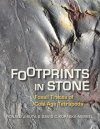By: Ronald J Buta(Author), David C Kopaska-Merkel(Author), Dana J Ehret(Foreword By)
328 pages, 45 colour & 109 b/w photos, 6 maps
![Footprints in Stone Footprints in Stone]()
Click to have a closer look
About this book
Customer reviews
Biography
Related titles
About this book
The Steven C. Minkin (Union Chapel) Paleozoic Footprint Site ranks among the most important fossil sites in the world today, and Footprints in Stone recounts the accidental revelation of its existence and detailed findings about its fossil record.
Currently 2,500 miles from the equator and more than 250 miles north of the Gulf of Mexico, the Minkin site was a swampy tropical forest adjacent to a tidal flat during the Coal Age or Carboniferous Period more than 300 million years ago. That fecund strand of sand and mud at the ocean's edge teemed with the earth's earliest reptiles as well as amphibians, fish, horseshoe crabs, spiders, jumping insects, and other fascinating organisms. Unlike dinosaurs and other large animals whose sturdy bodies left hard fossil records, most of these small, soft-bodied creatures left no concrete remains. But they did leave something else. Preserved in the site's coal beds along with insect wings and beautifully textured patterns of primeval plants are their footprints, fossilized animal tracks from which modern paleontologists can glean many valuable insights about their physical anatomies and behaviors.
The paleontological examination of fossil tracks is now the cutting-edge of contemporary scholarship, and the Minkin site is the first and largest site of its kind in eastern North America. Discovered by a local high school science teacher, the site provides both professional and amateur paleontologists around the world with a wealth of fossil track samples along with an inspirational story for amateur explorers and collectors.
Authoritative and extensively illustrated, Footprints in Stone brings together the contributions of many geologists and paleontologists who photographed, documented, and analyzed the Minkin site's fossil trackways. An engrossing tale of its serendipitous discovery and a detailed study of its fossil records, Footprints in Stone is a landmark publication in the history of paleontology.
Customer Reviews
Biography
Ronald J. Buta is professor of astronomy and astrophysics at the University of Alabama, USA, with his main interests in galaxy morphology and dynamics. He is the author of The de Vaucouleurs Atlas of Galaxies and the content creator of the Galaxy Morphology website hosted through the University of Alabama.
David C. Kopaska-Merkel is section chief of petroleum systems and technology at the Geological Survey of Alabama and a member of the National Center for Science Education. Both Buta and Kopaska-Merkel are members of the Alabama Paleontological Society and coeditors of Pennsylvanian Footprints in the Black Warrior Basin of Alabama.
By: Ronald J Buta(Author), David C Kopaska-Merkel(Author), Dana J Ehret(Foreword By)
328 pages, 45 colour & 109 b/w photos, 6 maps
"The Union Chapel fossil site (now known as the Steven C. Minkin Paleozoic Footprint Site) is globally important as the first large Carboniferous tracksite discovered in the world and as the first significant Paleozoic tracksite found in the eastern United States."
– Hartmut Haubold, Institute of Geological Sciences and Geiseltalmuseum, Martin-Luther-University, Germany
"The collection and cataloging of fossil trackway material from the Union Chapel Mine has provided a unique opportunity for the professional and the amateur paleontological communities to share in a scientifically significant undertaking. Determined efforts by members of the Alabama Paleontological Society to salvage the mine's rich and taxonomically diverse fossil vertebrate and invertebrate trackways before the impending reclamation of the site has resulted in a treasure trove of material that should provide important insights into the paleoecology of Coal-Age Alabama for many years to come."
– Jim Lacefield, author of Lost Worlds in Alabama Rocks: A Guide to the State's Ancient Life and Landscapes
"Footprints in Stone offers something for everyone. From the youngest amateur scientist to university-level paleontology students, the story of the discovery and preservation of the Minkin site is a good read that will both surprise and teach readers about a unique period of earth history that is preserved in central Alabama."
– Douglas W. Haywick, associate professor of geology, Department of Earth Sciences, University of South Alabama







































